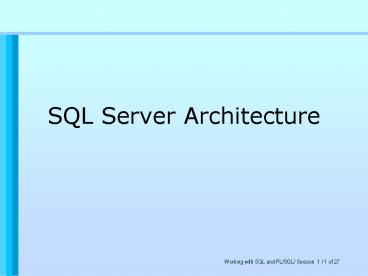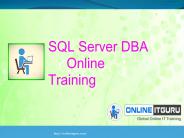SQL Server Architecture - PowerPoint PPT Presentation
1 / 27
Title: SQL Server Architecture
1
SQL Server Architecture
2
Objective
- Relational Database Components
- Database Architecture
- Logical Database Components
- System Databases and Data
- Physical Database Architecture
- Physical Database Files and Filegroups
- Transaction Log Architecture
3
Introduction
- In 1980s Microsoft Sybase teamed up to create
SQL Server. - After release of version 6.5, they both
separated. - It is SQL compliant RDBMS. ( Uses ANSI version
of SQL) - It supports the Client Server Model.
4
Relational features of SQL Server
- Information representation.
- Unique definition of rows.
- Systematic treatment of NULL values.
- Guaranteed access
- High level Update, Insert and Delete.
- Security
- Login authentication
- Permissions validation on user database.
5
Relational Database Components
- The database component of Microsoft SQL Server
2000 is a Structured Query Language (SQL)based,
scalable, relational database with integrated
Extensible Markup Language (XML) support for
Internet applications. - Each of the following terms describes a
fundamental part of the architecture of the SQL
Server 2000 database component
6
Database
- A database is a storage place for data. The
database does not present information directly to
a user the user runs an application that
accesses data from the database and presents it
to the user in an understandable format. - A database typically has two main parts first,
the files holding the physical database and
second, the database management system (DBMS)
software that applications use to access data.
7
- The DBMS is responsible for enforcing the
database structure, including - Maintaining relationships between data in the
database. - Ensuring that data is stored correctly, and that
the rules defining data relationships are not
violated. - Recovering all data to a point of known
consistency in case of system failures.
8
Scalable
- SQL Server 2000 supports having a wide range of
users access it at the same time. An instance of
SQL Server 2000 includes the files that make up a
set of databases and a copy of the DBMS software.
- Applications running on separate computers use a
SQL Server 2000 communications component to
transmit commands over a network to the SQL
Server 2000 instance.
9
Structured Query Language
- To work with data in a database, you have to use
a set of commands and statements (language)
defined by the DBMS software the most common is
SQL. - The American National Standards Institute (ANSI)
and the International Standards Organization
(ISO) define software standards, including
standards for the SQL language.
10
- The dialect of SQL supported by Microsoft SQL
Server is called Transact-SQL (T-SQL). T-SQL is
the primary language used by Microsoft SQL Server
applications. - Elements of Transact SQL
- DDL
- DML
- DCL
- TCL
11
Extensible Markup Language
- Although most SQL statements return their results
in a relational, or tabular, result set, the SQL
Server 2000 database component supports a FOR XML
clause that returns results as an XML document.
XML documents can be added to SQL Server
databases, and the OPENXML clause can be used to
expose data from an XML document as a relational
result set.
12
Database Architecture
- Microsoft SQL Server 2000 data is stored in
databases. The data in a database is organized
into the logical components visible to users. A
database is also physically implemented as two or
more files on disk. - When using a database, you work primarily with
the logical components such as tables, views,
procedures, and users. The physical
implementation of files is largely transparent.
13
- Each instance of SQL Server has four system
databases (master, model, tempdb, and msdb) and
one or more user databases. - It is not necessary to run multiple copies of the
SQL Server database engine to allow multiple
users to access the databases on a server. - An instance of the SQL Server Standard or
Enterprise Edition is capable of handling
thousands of users working in multiple databases
at the same time.
14
Logical Database Components
- The data in a Microsoft SQL Server 2000 database
is organized into several different objects. - Tables
- Constraints
- Indexes
- Defaults
- Triggers, Stored procedures, Views
- Keys
- User-defined functions
- User-defined data types
15
Physical Database Architecture
- The fundamental unit of data storage in Microsoft
SQL Server is the page. In SQL Server 2000, the
page size is 8 KB. - The start of each page is a 96-byte header used
to store system information, such as the type of
page, the amount of free space on the page, and
the object ID of the object owning the page
16
Continued..
- Data pages contain all the data in data rows
except text, ntext, and image data, which is
stored in separate pages. - Data rows are placed serially on the page
starting immediately after the header. - A row offset table starts at the end of the page.
The row offset table contains one entry for each
row on the page and each entry records how far
the first byte of the row is from the start of
the page.
17
- Rows cannot span pages in SQL Server. In SQL
Server 2000, the maximum amount of data contained
in a single row is 8060 bytes, not including
text, ntext, and image data - Extents are the basic unit in which space is
allocated to tables and indexes. An extent is 8
contiguous pages, or 64 KB.
18
Physical Database Files and Filegroups
- SQL Server 2000 databases have three types of
files - Primary data files
- This file contains all of the system tables and
other system objects. Also contains links to all
secondary data files log files. - Microsoft recommends that most databases will
work very well with only a single primary data
file log file. - The recommended file name extension for primary
data files is .mdf.
19
- Secondary data files
- Secondary data files comprise all of the data
files other than the primary data file. Some
databases may not have any secondary data files,
while others have multiple secondary data files. - Used to spread data over multiple disks.
- The recommended file name extension for secondary
data files is .ndf.
20
- Log files
- Log files hold all of the log information used to
recover the database. There must be at least one
log file for each database, although there can be
more than one. - If the server fails because of a power outage or
other problem, SQL Server automatically recovers
the database by applying committed transactions. - The recommended file name extension for log
files is .ldf.
21
- SQL Server 2000 files have two names
- logical_file_name is a name used to refer to the
file in all Transact-SQL statements. - The logical file name must conform to the rules
for SQL Server identifiers and must be unique to
the database. - os_file_name is the name of the physical file.
- It must follow the rules for Microsoft Windows NT
or Microsoft Windows 98, and Microsoft Windows 95
file names.
22
Database Filegroups
- Database files can be grouped together in
filegroups for allocation and administration
purposes. - Some systems can improve their performance by
controlling the placement of data and indexes
onto specific disk drives. - The administrator can create filegroups for each
disk drive, then assign specific tables, indexes,
or the text, ntext, or image data from a table,
to specific filegroups.
23
- There are two types of filegroups
- Primary
- The primary filegroup contains the primary data
file and any other files not specifically
assigned to another filegroup. All pages for the
system tables are allocated in the primary
filegroup. - User-defined
- User-defined filegroups are any filegroups
specified using the FILEGROUP keyword in a CREATE
DATABASE or ALTER DATABASE statement.
24
- One filegroup in each database operates as the
default filegroup. When SQL Server allocates a
page to a table or index for which no filegroup
was specified when they were created, the pages
are allocated from the default filegroup. - Only one filegroup at a time can be the default
filegroup. If no default filegroup is specified,
the primary filegroup is the default filegroup.
25
The Syntax
- CREATE DATABASE database_name ON PRIMARY
( ltfilespecgt ) LOG ON
( ltfilespec .. )
26
Creating Database
- CREATE DATABASE MyDB
- ON PRIMARY
- ( NAME'MyDB_Primary',
- FILE NAME 'c\data\MyDB_Prm.mdf',
- SIZE4,
- MAXSIZE10,
- FILEGROWTH1)
27
- LOG ON
- ( NAME'MyDB_log',
- FILE NAME 'c\data\MyDB.ldf',
- SIZE1,
- MAXSIZE10,
- FILEGROWTH1)































